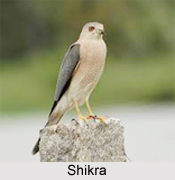 Shikra is an Indian Bird of prey with a scientific name "Accipiter badius", is a small bird in the family of Accipitridae concentrated in the parts of Asia and Africa where it is also called the little banded goshawk.
Shikra is an Indian Bird of prey with a scientific name "Accipiter badius", is a small bird in the family of Accipitridae concentrated in the parts of Asia and Africa where it is also called the little banded goshawk.
Categories of Shikra
Shikra are of many types. Some of them are the African forms that may represent a separate species but have usually been considered as subspecies of the shikra. The shikra is very similar in appearance to other sparrow hawk species including the Chinese goshawk and Eurasian sparrow hawk. They have a sharp two note call and have the typical flap and glide flight. Their calls are imitated by drongos and the common hawk-cuckoo resembles it in plumage.
Structure of Shikra
Shikra is a small raptor and like most other Accipiter hawks, this species has short rounded wings and a narrow and somewhat long tail. Adults are whitish on the underside with fine rufous bars while the upperparts are grey. The lower belly is less barred and the thighs are whitish. Males have a red iris while the females have a less red iris and brownish upperparts apart from heavier barring on the under parts. The females are slightly larger. The mesial stripe on the throat is dark but narrow. In flight the male seen from below shows a light wing lining and has blackish wing tips. When seen from above the tail bands are faintly marked on the lateral tail feathers and not as strongly marked as in the Eurasian sparrow hawk. The central tail feathers are unbanded and only have a dark terminal band. Juveniles have dark streaks and spots on the upper breast and the wing is narrowly barred while the tail has dark but narrow bands. A post juvenile transitional plumage is found with very strong barring on the contour feathers of the underside. The call is pee-wee, the first note being higher and the second being longer. In flight the calls are shorter and sharper kik-ki ... kik-ki. The Chinese sparrow hawk is somewhat similar in appearance but has swollen bright orange ceres and yellow legs with the wing tips entirely black.
Concentration of Shikra
Shikra is found in a range of habitats including forests, farmland and urban areas. They are usually seen singly or in pairs. The flight is typical with flaps and glides. During the breeding season pairs will soar on thermals and stoop at each other. Their flight usually draws alarms among smaller birds and squirrels. They feed on rodents, squirrels, small birds, small reptiles (mainly lizards but sometimes small snakes and insects. Small birds usually dive through foliage to avoid a shikra and a Small Blue Kingfisher has been observed diving into water to escape. Babblers have been observed to rally together to drive away a shikra. They will descend to the ground to feast on emerging winged termites, hunt at dusk for small bats and in rare instances they may even resort to feed on carrion.
Breeding of Shikra
The breeding season of Shikra in India is in summer from March to June. The nest is a platform similar to that of crows lined with grass. Both sexes help build the nest, twigs being carried in their feet. Like crows, they may also make use of metal wires. The usual clutch is 3 to 4 eggs which are pale bluish grey stippled on the broad end in black. The incubation period is 18 to 21 days.



















